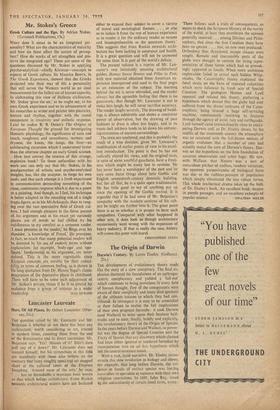Lancaster Laureate
THE question raised by Mr. Lancaster and Mr. Betjeman is whether or not there has been any architecture, worth considering as art, erected in modern times, counting these from • the end of the Renaissance and its direct succession. Mr. Betjeman says, 'Yes! Masses of it! Don't dare pull any of it down!' Mr. Lancaster does not commit himself, but his sympathies in this field are manifestly with those who believe on the contrary that (very roughly speaking) art stopped short at the cultured court of the Empress Josephine. 'Around none of the arts,' ,he says, . . has so formidable a mystique been woven as that which befogs architecture. From Ruskin onwards architectural writers have not hesitated either to expand their subject to cover a variety of moral and sociological themes; . . . or else so to isolate it from the rest of human experience as to render it for the ordinary reader as remote and incomprehensible as the quantum theory.' This suggests that from Ruskin onwards archi- tecture has been lacking in assurance and health. It is a great question and will not be answered for some time. It is part of the world's debate.
The present volume is a reprint of Mr. Lan- caster's two inimitably amusing architectural guides, Homes Sweet Homes and Pillar to Post, with new material obtained from American ex- perience interspersed and used in the final pages as an extension of the subject. The learning behind the wit is never obtruded, and the reader always has the agreeable feeling that there is no guesswork; that though Mr. Lancaster is out to make him laugh, he will never sacrifice accuracy. The reader laughs securely. The drawing of build- ings is always admirable and shows a consistent power of observation, but the drawing of past fashions in dress is often less happy, and in its music-hall jokiness tends to let down his entranc- ing evocations of ancient surroundings. The texts are unaltered, and this is probably the result of a wise decision, given Mr. Lancaster's modification of earlier points of view in his excel- lent introduction. The point is that he has not radically altered his views, and the original texts, in spite of some youthful gaucherie, have a fresh- ness which might be easily lost in revision. He has never' been a worshipper of the past and he says some fierce things about later Gothic and English seventeenth-century domestic building, but, for all that, he is a 'quite open traditionalist. He has little good to say of anything put up since the opening of the Gothic revival. It is arguable that if he had some of Mr. Betjeman's sympathy with the modern sections of his sub- ject he might see further into it. The great point there is as to whether it is proper to have such sympathies. Compared with what happened in other arts, it does look as though architecture mysteriously went wrong with the expansion of heavy industry. If that is really the case, -history will crown this jester with laurel.
CHRISTOPHER SYKES










































 Previous page
Previous page